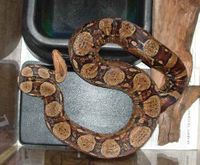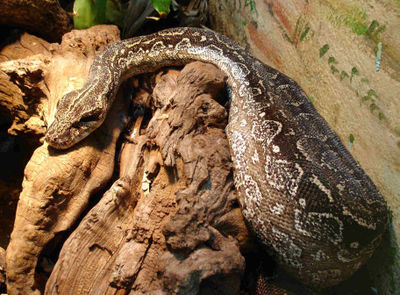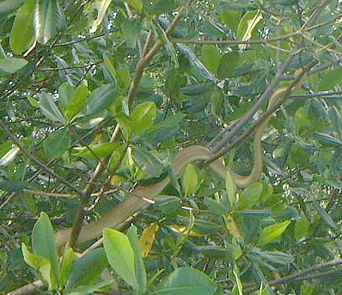| Boidae | ||||||||||||
|---|---|---|---|---|---|---|---|---|---|---|---|---|

Red-tailed Boa, Boa constrictor
|
||||||||||||
| Scientific classification | ||||||||||||
|
||||||||||||
|
Acrantophis Boa Candoia Corallus Epicrates Eryx Eunectes Gongylophis Sanzinia |
Boas are a type of snake that are members of the Boidae family. Boas are basal snakes that are "primitive" in evolutionary terms (i.e. less derived). They are constrictors and most give birth to live young. They have anal spurs, a pair of claws on each side of the cloaca which assist in mating. Boas are named after cows (Latin: bos) because of the old myth that boa snakes pursue cows and suckle them until they are drained to death.
Boas have two subfamilies: Boinae or true boas and Erycinae or sand boas. Pythons are sometimes classified as a subfamily of Boidae, but are frequently listed under their own family, Pythonidae.
Boidae
True boas are medium sized to large snakes. Females are usually larger than their male counterparts. Boas contain many subspecies based on locaility. They include Colombian, Suriname, Bolivian, Peruvian, Hog Island, Long Tail Peruvian, Argentine and more. The boas from the amazon basin are the most colorful possessing bright cherry red tails. It used to be said that boas were New World Snakes and pythons were Old World Snakes, but, with boas found on Madagascar and the Solomon Islands, this is not quite true. Instead, it is possible that boas have survived in evolutionarily isolated areas. South America, until a few million years ago, had a distinct fauna that included marsupial mammals; with the land bridge to North America, boas have migrated north as placental mammals and colubrids (for example) have migrated south.
- Acrantophis (Dumeril's Boa and Madagascar Ground
Boa; sometimes equated with Boa)
Boa (Red-tailed Boa, Boa constrictor, and relatives)
Candoia (Pacific boas)
Charina(Rosy boas)
Corallus (Tree boas)
Epicrates (Rainbow boas and Island boas)
Eryx (Sand boas, Eryx johnii)
Eunectes (Anacondas)
Gongylophis (Gongylophis conicus)
Sanzinia (Madagascar Tree Boa; sometimes equated with Boa)


Erycinae
Compared to true boas, erycines are quite small, with most members of this subfamily remaining well under a metre in length. Fossil erycines have been found in rock strata over 50 million years old, and were once widespread in North America. Now, only two species remain in North America, as well as the sand boas in Africa, Asia and southeastern Europe.
At least three erycine species lay eggs: the Calabar Burrowing "Python" , Calabaria reinhardtii (once classified as a python for this reason); the Arabian Sand Boa, Eryx jayakari; and the West African Sand Boa, Eryx muelleri.
- Calabaria reinhardtii (Calabar Burrowing "Python",
Africa; sometimes equated with Charina)
Charina bottae (rubber boas, west coast of North America)
Eryx (Sand boa, Africa, western Asia and southeastern Europe)
Lichanura trivirgata (Rosy boa, southwestern U.S. and northwestern Mexico; sometimes equated with Charina)




 216.73.216.190
216.73.216.190 User Stats:
User Stats:
 Today: 0
Today: 0 Yesterday: 0
Yesterday: 0 This Month: 0
This Month: 0 This Year: 0
This Year: 0 Total Users: 117
Total Users: 117 New Members:
New Members:
 216.73.xxx.xxx
216.73.xxx.xxx
 Server Time:
Server Time: